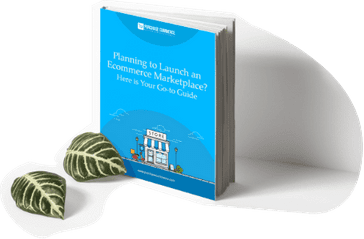9 Hacks to Know about Marketplace Software for Running a Successful Online Business
Ecommerce is the hectic business, spreading like a fire in the online industry. Statistics revealed that ecommerce sales are hitting the peak and expected to achieve $4.5 trillion in 2020. If you are entered into this field, then you might be lucky to develop your business worldwide in a profitable way.
Most of the people want to start Marketplace business like Amazon or eBay because of its high profit. If you are going to start an ecommerce marketplace then you are in the right place.
Here are some tips and strategies you should know to get success in this ecommerce marketplace business. We will start the discussion with benefits.
3 Vital Benefits You Will Attain in Online Marketplace Software:
-
If you are a business entrepreneur, running your physical store or providing services to your local people, then b2c marketplace software is the best platform to grow your business all over the world. This will lead to generating huge traffic to your business.
-
Targeting the right customers is the main thing in achieving success in any business. Hence this online marketplace software website helps you to find your targeted customers by using tools. We will discuss the tools later in the hacks.
-
Promoting your business is also another important activity that will also be easy in online business.
Multi-vendor Marketplace
Multi-vendor ecommerce software is a popular platform for a successful ecommerce business. In Multivendor, you are the admin and you can design the store platform. Then you have to invite multiple vendors to sell their products and services in your platform. Example: Amazon. Flipkart
Pros if you’re an Admin:
You can invite multiple vendors and you have the right to check the vendor’s products. The money transaction is maintained by the admin(you) and you can earn money as a commission fee by many vendors. You can also have customizable options to design the store features based on your choice.
Pros of a Vendor:
If you are not an admin of the marketplace software, then don’t worry. You will just find the best multi-vendor marketplace software and register your business on that platform. Then start selling your products and services to your valuable customers and make money.
Pros of a Customer:
Since this platform contains multiple choices for a single product or service, it is easy to compare the things and prices and it’s easy to purchase the appropriate one. Also, due to a huge number of stores available in one place, there will be many deals and offers to purchase happily.
Classifications of Marketplace Software:
General Marketplace
Here in this marketplace software, you can design the store and many vendors will sell different types of products to the customers. E.g.: Amazon, Flipkart.
Special Marketplace
Here, this marketplace will focus on a particular niche. The vendors will sell only a set of products to the customers. E.g.: Myntra
Ready to buy Marketplace Software or updating the existing one with the latest software?
Purchase Commerce is the best online marketplace software to buy as it is based on next-gen Angular and Node technology. Purchase Commerce provides both single-vendor and multivendor marketplace software at an affordable price.
Normally, Multivendor Marketplace Software business model falls into different categories as follows:
1. B2B Marketplace: (B2B-Business to Business)
In the B2B marketplace software, one brand will sell their products and services to another brand. Example: Alibaba, eBay, etc.,
2. B2C Marketplace: (B2C-Business to Consumer)
B2C marketplace software is a traditional marketplace model where the sellers sell products and services directly to their targeted customers.
Example: Amazon, Flipkart, eBay, etc.
These will be an example for the three B2B, B2C, and C2B business models as it contains three business process but B2C is the most popular method. Some other popular B2C marketplace software: Netflix, McDonald’s, etc.,
3. C2C Marketplace: (C2C-Consumer to Consumer)
C2C marketplace software is one of the models where one customer sells its products to another customer via a third-party marketplace platform. Example: OLX, Quikr, etc.,
4. C2B Marketplace: (C2B-Consumer to Business)
In the C2B marketplace software, the Consumer produces new product ideas to the business and the business will pay some amount to that consumers. Or it is also said as if the consumer reviews about particular products in a good way and it helps the business to generate some traffic by the consumers, this C2B. E.g.: Amazon.
5. E-Government:
E-Government is a type where the public services are provided via the digital platform. It has types like:
- G2G- Government to Government business transactions
- B2G-Business to Government Transactions
- G2C-Government to Citizen Transactions
Choose the best marketplace platform and business model according to your requirements.
Once you plan the idea and purchase the best multi-vendor marketplace platform, or set up the basis of the store, it’s time to improve the business to a high level.
In wide, there are numerous business models available to start your ecommerce business. But the problem is to choose but them and understanding which will suit your business and in which base they differ from each other.
To know about the marketplace basics read out the blog Different Types of E-marketplace: Comparisons with Examples that help you decide what kind of multi-vendor store is the right business model for you.
9 Hacks You Should Know for running an Ecommerce Marketplace Business Successfully
Now the actual topic comes...
These hacks and marketing strategies will help you to become successful in the Marketplace Software business. The nine hacks are:
- Niche and Competitor Research
- Implement Your Business Brand
- Customize the World Class Online Store
- Vendor Management
- Tuning Your Online Store
- Build Social Profiles
- Product Promotion
- Using the right Tools
- Customer Fulfillment
1. Niche and Competitor Research
Niche Research:
A niche refers to the particular products or services that you are going to sell.
You can either sell various products (like outfits, cosmetics, books, housewares, etc.,) or concentrate on only one product (like fashion/technology/books, etc.,). This is meant by Niche’s selection. You probably know which products or services are in the trend between the customers.
Another great thing to note is ‘Your Business and Niche Interest’. Find the product in which you are knowledgeable and interested.
Choose the right vendors who match your Niche interest.
Competitor Research:
Is it necessary to do competitor research?
Yes, it is most important.
As you know, today the world is filled with ecommerce purchases, there are more and more competitors will be waiting for you to compete. Also, you know that everyone falls for individual things.
How will you be unique from others to stand out from the competition?
By doing the competitor analysis. The following things are to be analyzed in your competitor analysis.
- You have to find the used and not used keywords by the competitors. So that you can use those, not-used competitors keywords to rank your business in those search terms.
- Also, you have to check the competitor store’s appearance. Design is a colorful thing that attracts the customer. Hence check your competitor’s store features. Establish the not used features in your store.
- And the last thing is the Competitor growth, sales, and traffic. For this, tools are used which will be discussed afterward.
2. Implement Your Business Brand
Once you decided which products to sell (along with its search terms) and completed doing competitor analysis, it’s time to implement your ideas into the real-time process.
Brand Name:
A brand is the identity of your business for lifelong. So, create a brand name that should satisfy the PACE terms.
[P-Proper Pronunciation
A-Attractive
C-Crystal Clear and Short
E-Easily Understandable]
Example: Amazon is the popular brand name- It is easily understandable, pronounceable, short, and attractive.
Domain Name:
Once purchased the marketplace website software, you have to create the domain name for that software website to develop the online store.
Name the domain as same as your brand name, so it will be helpful for your customers to find your business easily. Amazon has its domain name (amazon dot in) which is the same as its brand name.
Buy TLD: TLD is Top Level Domain. Purchase the high-level domain (like .com for a common purpose). If you are focusing on the particular region to sell your products, then buy the domain according to that. (like co.uk for London, .in for India, .us for America, etc.,) By doing this, ranking your business site will be easier in that particular region.
Branding: The sellers will register their business infamous digital marketplace software to develop their business. Hence make your brand name popular by creative ideas like funny videos and advertisements to indulge the sellers and buyers to your white label software marketplace.
If you are having an existing domain name, then you will use it.
3. Customize Online Store to World Class Level
Now it’s time to customize your dream online store. You have to maintain all the necessary features for your ecommerce platform.
The significant features that should be found in the ecommerce platform are:
Payment Gateway
It is the mode of payment, the customers paid for the products. You have to enable all types of payment models like online, COD, to engage the customers from the local place to cities to purchase more.
Stock Management
The proper UI to display stock management is necessary. The admin and the vendors have to check the number of stocks available in the store. The store dashboard has to display the products which are currently in the stock. You have to avoid showing the products that are not available in the store.
Customer Management
It is also important to manage the customer activities by proper User Interface. CRM (Customer Relationship Management) is the process where you can maintain your customer and organization relationships properly to retain your customers.
Multi-lingual Support
Since your marketplace website software will reach many people in many regions, it has to support all the local languages accessed by each region. The content on the website should be adjusted by the user according to their language.
Multiple Currency Support
Similarly, the currency of the country will also be changed. So, you have to update the multiple currency support.
Complete Customizable Platform
If the store has many customizable options, it makes the customers organize their store dashboard and personal settings.
Proper License
All the vendors will be given the required identity to access the platform and you have to buy the licensed platform to avoid any legal issues.
If you are providing the best marketplace platform, then many vendors will find your space helpful and will register their business in your b2c marketplace software platform.
You, the admin has to check the product details and want to handle the money transactions properly.
Purchase Commerce will provide you with rich and innovative angular themes that are apt for setting and running your multi-vendor ecommerce business successfully.
You can buy the latest tech peer to peer marketplace software platform to delight your vendors and customers with different features.
4. Vendor Management
If your brand is popular, then the vendors will give you the business request directly to your online marketplace software.
But if you are starting a new ecommerce business, then you have to invite many vendors to start their online business on your platform.
How will you find vendors?
I will mention some points that show where you will find your valuable vendors.
By Advertisement:
Advertisement is the easiest way to announce your new business. Hence you can create funny ads and short-videos and describe your work process shortly to invite new vendors to your ecommerce space. By making ads based on your niche, you will find the appropriate vendors who meet your niche requirements.
Some other ways:
By Local Directories:
You can find many local directories like Yellow Pages, Manta, Yelp, CitySearch, Merchant Circle, etc., where many vendors will list their business details. You can analyze their details and send an invitation to join your ecommerce platform.
Vendor Association:
In every business, there will be a certain association related to vendors and workers. Hence by verifying the vendor association, you will have the opportunity to find your vendor to send the invitation.
Merchandise Fair:
You can attend the fairs provided for the merchandise so that you will find many vendors directly and it’s easy to convey your business to them to give the vendor invitation.
Analyze the suited method for you and invite organic vendors to make the ecommerce trade.
5. Tuning your Online Store
After inviting the vendors and finished registering the vendor’s business in the service marketplace software platform, the next step is, organizing the online store.
In general, you can add products to the store in two ways:
- You, the admin will upload the product to the store
- The vendor has to upload their products (It’s the easy way to add products quickly in the store).
In these two ways, you can add products to the online store. But you have to analyze the product details, expiration date (if it is a food product), quality and place the best products in the store dashboard. Also, you have the right to approve and disapprove of the products to sell in that store.
You can use the rating system to collect feedback from the vendors to make regular changes in the platform. Feedback will be one of the best ways to improve your ecommerce store performance.
Fee Optimization:
You can earn a commission fee by the vendor when the purchase transaction made. Besides, you also earn money when the vendor registers their business in the form of the subscription fee.
You have to change the subscription fee seasonally or yearly to improve your business.
The store should have a customized product category page where the products will be categorized in a particular order with a filter option. So that the customer will find the required products easily and will be attracted by the feature of the store easily resulting in the form of regular customers. In this cause, you have to properly maintain the features of the store in a customized way.
Providing Deals and Offers:
As an admin, you have to provide some seasonal offers to the vendors for subscription and renewal fees to make vendors happily continuing their business in your platform.
Price Comparison:
You can provide the same price range for all vendors and have to maintain the price list of the product wisely.
The price comparison list should be properly maintained because the customer needs the price list option to check the prices.
Shipping Process:
Once the purchase is confirmed, the admin has to take responsibility to confirm whether the product shipping process is completed on time or not. If not, take action to solve the problems of the customers.
6. Build Social Profiles
Once all your store organization is finished, it’s time to reach targeted customers. Social media provides you many best options to list your products and services to your customers.
Posting regular images, videos, articles in a social profile will help you to rank more in the search engines.
Mobile Apps:
While saying social media apps, most of the customers access the app on mobile. Optimizing the website performance according to mobile format is another important activity to consider as the mobile users are higher than the desktop users and website users.
Hence develop your ecommerce platform also in the form of mCommerce apps.
The popular social media to use are:
On Facebook, you have a chance to create a business page where you can list your business to get the customers. (both sellers and buyers)
Similar to Facebook, Instagram also has a business page to showcase your products and services to the world.
You can tweet your products by using hashtags to make your products and services in the trend to your customers.
LinkedIn is meant for business information where a detailed description of your business update is necessary to describe your work process and quality of the store.
Pinterest especially used for high-quality images, so you can use the HD business image with your business detail to reach the customers.
YouTube
YouTube is the second popular platform next to Google. Hence you can make explainer videos or animation videos to engage with your customers.
-Use the social media platform wisely and make organic customers.
The following things are mandatory to your social business profile:
- Clear Business Dp with your brand name
- Proper Brand or Business Name
- Contact Details like physical address(optional), Phone number, Mail-Id, Location Map, and other online store details.
- HD images representing your work process
7. Product Promotion
Finished building your social profile? We will start the discussion about how to do marketing perfectly?
Keyword Optimization:
Keywords are the search term; customers use to search particular products or services. For example, the best marketplace software is the term, some of you used to search for knowing the best ecommerce platform.
Keyword Optimization is the first and foremost activity you have to do to find your popular niche search terms. Once you find the correct keywords or niche terms, then you are ready for the next step.
Marketing Ways:
(i) SEO:
Search Engine Optimization (SEO) is the strategic activity that will be easy if following it in the right way with patience. SEO categorizes into On-Page SEO and Off-Page SEO.
On-Page SEO- It includes the title, meta description, and all the contents of the website. You have to optimize these contents based on keywords to rank more in search engines.
Off-Page SEO- It helps to rank the top in search engines. It is done in both free and paid versions. This activity includes listing in local directories, classified and Social Bookmark Submission, article submissions, etc., where you have to list your ecommerce business details so your website will reach many of your targeted customers easily.
(ii) Social Media Marketing (SMM):
Social Media Marketing (SMM) simply means paying the amount to Google or some other search engine for displaying your business ads based on keywords. It will help you to reach your customers easily but includes payment. For a beginner, SMM will not be easy as it needs amount. After certain improvements, you can invest here to get huge traffic.
Social Media Optimization (SMO) is significant (i.e.,) optimizing your social media content along with the keywords.
(iii) Content Marketing:
Content marketing will act like a king to your website, hence write the best readable contents in the form of articles and publish it in your blog.
(iv) Email Marketing:
Providing offers is necessary to retain existing customers. Here Email marketing will help you. You can send an email to your customers about your offers and deals to announce your business status.
Make sure to use all of the marketing ways to promote your products and services to the customers.
(v) Video Marketing:
Video Content will be the future content consuming platform and YouTube is the second-largest Search engine. Hence create engaging animated videos related to your niche to attract the customers.
(vi) Search Engine Marketing:
Search Engine Marketing (SEM) is similar to SEO to promote your business, but SEM is in the form of paid marketing. You can bid your business details in the form of the ad to the search engine to display your business in the top position. Whenever the customer clicks your ad, you have to pay some amount to the search engine. So, make your ad carefully based on keyword optimization.
8. Using the right Tools
How do you analyze your customer behavior?
There are many analytics tools available in the online market.
Google Analytics is the best and free tool to use. In Google Analytics, you can able to analyze the following features:
-
Keywords: Keywords used by the customers is displayed so that you can optimize the content based on that.
-
Location: Location where the customers located and do the search so that you can focus on that region more to make ads with the local language to attract the local audience
-
Device: Device used by the customers to make research like desktop, mobile, tablet, so that you can make your website accessible in mobile and desktop format
-
Browser: The browser used by the customers will also be shown so that you can optimize the website appearance in all the search engines.
-
Timing: The time spends by the customers on your website on a particular page, so that you can improve the content of the other pages easily.
-
Filter: Many filter options to customize your customer behavior’s research to target your customer.
So, by making use of this tool, analyze the customer’s behavior and make optimizations based on the outcomes.
We already discussed the competitor’s analysis which will also be performed by using this tool. Enter your competitor’s website and make a quick insight into the competitors’ activity and try to establish the features in your online store that does not appear in your competitor site.
I assure that this tool will give solutions to all your queries just by signing in that platform.
9. Customer Fulfillment:
After making a proper analysis, update your content and website, based on related keywords and user behavior.
Search terms will be changed periodically (that depends on the audience), hence make sure to optimize appropriate keywords and update your content regularly to rank higher in search engines.
Word of Mouth Marketing:
You can do all these steps to meet your customer requirements. Hence make sure to complete all these activities and provide the best services to your valuable customers.
When the customer is believed in your product quality and inspired by your services, then the customer will become an indirect brand ambassador to your business by recommending your services to their friends.
Retargeting:
Retargeting is the popular term used in the ecommerce domain, which means retargeting the existing customers with different deals and offers.
To make the existing customers purchase more, you have to give special offers to encourage them to shop more.
Tracking:
Tracking your customer activities is important to examine whether the customer completes the purchase or not. If not, retargeting them with exciting offers makes them complete the purchase.
Tracking is also simple by pasting the tracking HTML code to your website.
In short, updating the existing one with new features will be strongly appreciated to increase your website performance and to increase organic traffic to your marketplace software platform.
Bonus Tips
Communication with customers:
Use the live chat option to communicate on spot with your customers or audiences who have visited your site. When someone enters your ecommerce platform, they may not be able to understand the navigation. Hence by communication, you will help them by solving their queries.
Feedbacks:
Collecting regular feedbacks from the user is necessary to know the performance of your store and you have to update the problems with necessary solutions.
24/7 Customer Support:
Providing all-time customer support is also important to retain the hope of your customers.
To Wind Up:
If you are running a marketplace business already then, these hacks will help you to gradual improvement your business traffic. You will attain more organic customers when you activate these 9 steps in your work process.
On the other hand, if you are new to marketplace business or going to start it will help you in some way to develop your marketplace software and run a business efficiently.
Purchase Commerce is the best multi-vendor marketplace software where you can purchase the platform at a one-time payment along with a lifetime subscription method. Also, Purchase Commerce provides you a free video demo session to give you a platform tour before purchasing it.
Let’s make a friendly conversation and start developing your business ideas. Contact Now our experts.












